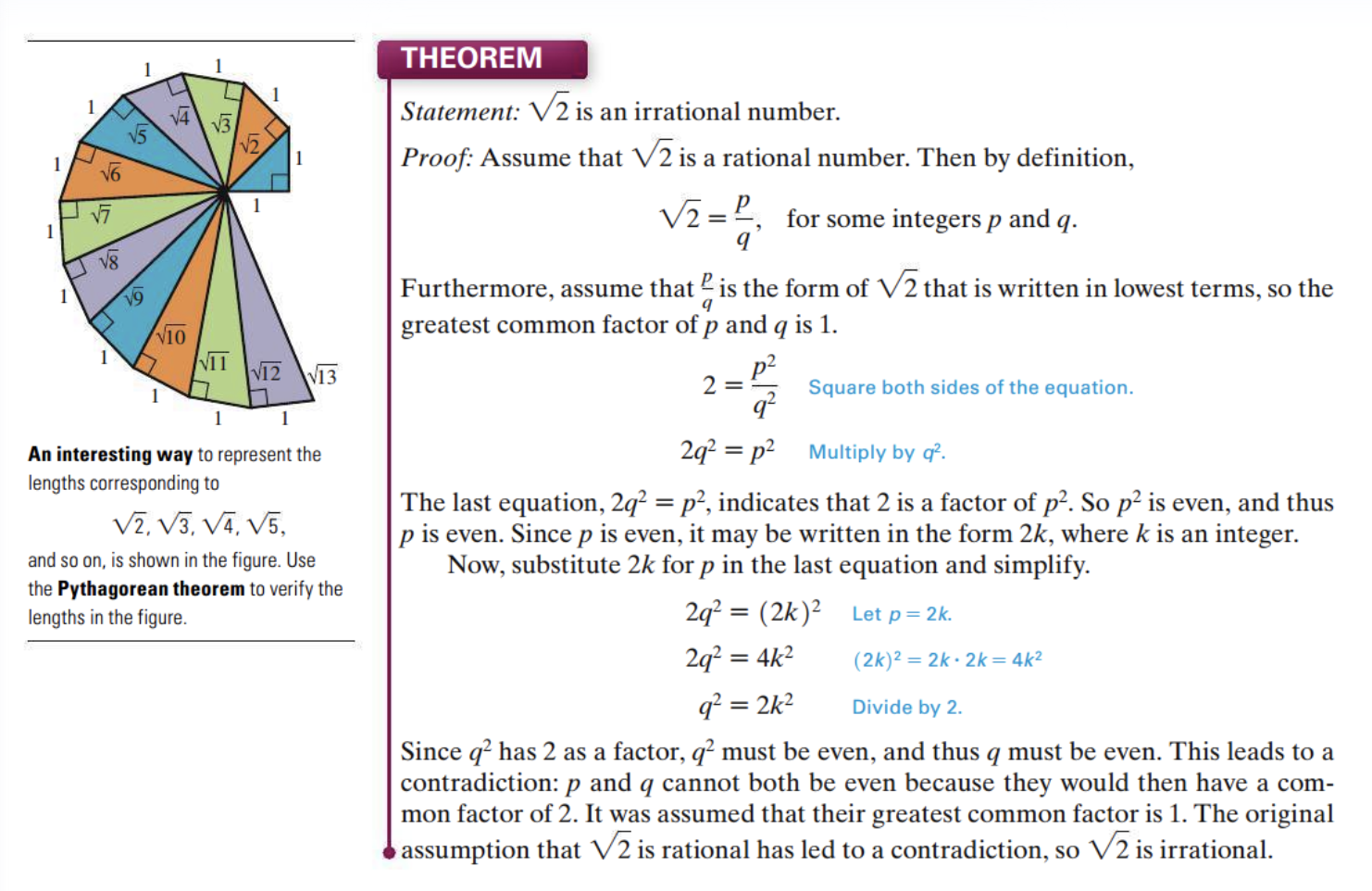[Func-Num] 6.4 Irrational Numbers and Decimal Representation
Categories: Func-Num
Tags: Decimal Irrational
📋 This is my note-taking from what I learned in the class “Math175-002 Functions & Number Systems”
Objectives
- Illustrate how irrational numbers differ from rational numbers in their decimal representations
- Follow the proof that sqrt 2 is an irrational number
- Use a calculator to find square roots
- Apply the product and quotient rules for square roots
- Rationalize a denominator
- Explain the relevance of the irrational numbers such as the Golden Ratio, the ratio of the circumference of a circle to its diameter, and a constant approximately equal to 2.71828
Definition and Basic Concepts
- Every rational number has a decimal form that terminates or repeats, and every repeating or terminating decimal represents a rational number
- However, there are numbers that do not terminate and do not repeat → We call this “Irrational Numbers”
Irrational Numbers
Irrational numbers = {
\({x \over x}\)
is a number represented by a nonrepeating, non-terminating decimal}
→ As the name implies, an irrational number cannot be represented as a quotient of integers
- E.g. root, the Golden Ratio, the ratio of the circumference of a circle to its diameter, and a constant approximately equal to 2.71828 …
Irrationality of root 2 and Proof by Contradiction
The proof that root 2 is irrational is a classic example of a proof by contradiction. We begin by assuming that root 2 is rational, which leads to a contradiction, or absurdity. The method is also called reductio ad absurdum (Latin for “reduce to the absurd”). In order to understand the proof, we consider three preliminary facts:
- When a rational number is written in lowest terms, the greatest common factor of the numerator and denominator is 1.
- If an integer is even, then it has 2 as a factor and may be written in the form 2k, where k is an integer.
- If a perfect square is even, then its square root is even.

Operations with Square Roots
- Recall that \(\sqrt{a}\) , for a >= 0, is the nonnegative number whose square is a
- That is, {(\(\sqrt{a}\))}^2 = a
Examples of square roots that are irrational: \(\sqrt{2}\), \(\sqrt{3}\), and \(\sqrt{13}\)
Examples of square roots that are rational: \(\sqrt{4}\) = 2, \(\sqrt{36}\) = 6, and \(\sqrt{100}\) = 10
- If n is a positive integer that is not the square of an integer, then 2n is an irrational number.
- A calculator with a square root key can give approximations of square roots of numbers that are not perfect squares.
- We use the ≈ symbol to indicate “is approximately equal to.”
- Sometimes, for convenience, the = symbol is used even if the statement is actually one of approximation, such as pi = 3.14.
Product Rule for Square Roots
For nonnegative real numbers a and b, the following holds true
\(\sqrt{a}\) * \(\sqrt{b}\) = \(\sqrt{a*b}\)
Conditions for a Simplified Square Root Radical
Just as every rational number \({a \over b}\) can be written in lowest terms (by using the fundamental property of rational numbers), every square root radical has a simplified form
A square root radical is in simplified form if the following three conditions are met:
- The number under the radical (radicand) has no factor (except 1) that is a perfect square
- The radicand has no fractions
- No denominator contains a radical
Quotient Rule for Square Roots
For nonnegative real numbers a and positive real numbers b, the following holds true
\({\sqrt{a} \over \sqrt{b}}\) = \({\sqrt{\) {a \over b} \(}}\)
Adding and Subtracting Square Root Radicals
- Square root radicals may be combined, however, if they have the same radicand. Such radicals are called like radicals. We add (and subtract) like radicals using the distributive property.
- Like radicals may be added or subtracted by adding or subtracting their coef-ficients (the numbers by which they are multiplied) and keeping the same radical.
Exercise
Section 6.4: 7 ~ 19 (odd)
Identify each number as rational or irrational
- 7: 4/9 → rational
- 9: root 10 → irrational
- 11: 1.618 → rational
- 13: 0.41 (repeating 41) → rational
- 15: Pi → irrational
- 17: 3.14159 → rational
- 19: 0.878778777877778… → irrational
Section 6.4: 23 ~ 29 (odd)
Use a calculator to find a rational decimal approximation for each irrational number
- 23: root 39 → 6.244 997 998 4
- 25: root 15.1 → 3.885 871 845 55
- 27: root 884 → 29.732 137 494 6
- 29: root 9/8 → 1.060 660 171 78
Section 6.4: 49 ~ 67 (odd)
Use the methods of Examples 3 and 4 to simplify each expression. Then, use a calculator to approximate both the given expression and the simplified expression. (Both should be the same.)
- 49: root 50 → 5(root 2) → 7.071 067 811 87
- 51: root 75 → 5(root 3) → 8.660 254 037 84
- 53: root 288 → 12(root 2) → 16.970 562 748 5
- 55: 5/(root 6) → 5/6(root 6) → 2.041 241 452 32
- 57: root (7/4) → (root 7)/2 → 1.322 875 655 53
- 59: root (7/3) → (root 21)/3 → 1.527 525 231 65
Use the method of Example 5 to perform the indicated operations
- 61: root 17 + 2(root 17) → 3(root 17)
- 63: 5(root 7) - root 7 → 4(root 7)
- 65: 3(root 18) + root 2 → 10(root 2)
- 67: -(root 12) + root 75 → 3(root 3)

Leave a comment